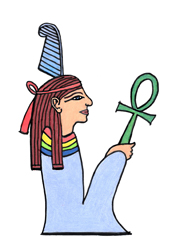|
November 15, 2017
What are you thankful for in this religion? How are you blessed?
What am I thankful for? How am I blessed? There are so many things for which I'm continually grateful. I'm grateful for a loving partner and good friends. I'm grateful for good health. I'm grateful Julia's health is improving after several scares. I'm grateful for a roof over our heads and good food. I'm grateful for meaningful work that provides a much needed service to our local community. I'm grateful for creative expression and the many ways I can use to actualize that.
But what am I most recently grateful for? From the beginning of this new Kemetic year, Julia and I have had our share of challenges. Actually, from the beginning of the mundane year, there's been challenges. But those have mostly been adjusting to changes on a global front. From the beginning of the Kemetic year, starting in August, challenges have gotten personal!
I am grateful for learning lessons.
I went to retreat this year, enjoying gathering with Kemetic friends, learning the Gods over the year, when I came back to my hotel room afterwards to learn Julia had taken sick. She thought it was food poisoning. I thought she should go to ER, but Julia was reluctant to and thought she could tough it out.
The Deities over this year are Sekhmet and Ma'at. I prayed to Sekhmet that she would bring healing to Julia.
A mindfulness workshop at retreat spoke of the impermanence of things. Emotional states come and go. I was thinking, "This gathering is so wonderful, I can hardly believe I'm here, I'm so excited!"
A few days later, after I returned home, Julia's pain grew so intense, she was willing to go to ER. As I sat waiting while she was undergoing tests, I thought, "This is so horrible, I can hardly believe we are going through this, I'm so terrified!"
As Julia went through a roller coaster of new things to test us, I went through alternating shock and relief. Does Julia have cancer? No. Two low electrolyte induced seizures, does she have brain damage? No. A scan of her intestinal blood vessels revealed she was in serious trouble, and her colon was dying. They rushed her to St. Joe's in Phoenix where complex, innovative surgical procedures removed the twisted blockages in her veins, a complication of Venous Arterial Malformation.
After the surgeries, she was able to come back to Yuma, but she couldn't return directly home. She couldn't get out of bed or a chair on her own. She sustained this damage earlier, when she wasn't eating, and her electrolytes got so low.
Gradually, the therapists worked with her to be able to manage these basic skills and Julia was able to come home at last.
Each little victory brought its share of rejoicing. Then the terror of the "what-ifs" would follow. How should I respond? An online chat on the theme of "Never Assume" got me thinking in terms of making assumptions about the future. For example: If Julia had a good day, "Hooray, she's coming home soon!" But if Julia had a bad day, "Wahhh, she's gonna die soon!" Or in the case of certain world leaders who say incendiary things, "There'll be nuclear world, we'll all die!" This doesn't allow for mitigating factors.
It's hard to let loose of the assumptions, to just enjoy each visit with Julia, for example. All of this comes from the same place as making assumptions about what people are thinking. It all regards things we can't know!
I had to learn to rejoice in each little victory for its own sake. I remembered a favorite quote:
"Life only demands from you the strength that you possess. Only one feat is possible; not to run away."
The important thing is just being there, for instance, just being there for Julia. To be fully there, during the moment, whatever its potential.
It takes a kind of grace to just be open to the moment and not tie it to a future moment. To learn the grace of being "here, now", this a special opportunity for growth for me this year.
And what are the words of this year's "Aset Oracle"?
"There is today, this day. There is what you are, where you are, and when you are, Now. Right now. Cease chasing after an impossible moment because it has not yet come. Now, your present moment in time, the gift of mortal lives, is yours. Until you know immortality, you have no need to chase it. You may as well chase the boat of Ra. You have love, and you have Now. Cease thinking, cease chasing. Be. Be now. Be in Ma’at at the moment of Zep Tepi, your moment of Zep Tepi, your moment of creation. Take this creation into your hands, and take it up. Be it. Live. Love. Be now."
--- (From the Aset Oracle, Year 25)
I am grateful for "now", this moment of being alive, and what I can do in this moment.
Zep-Tepi defined:
Ma'at defined:
"This single name expresses all notions of equilibrium and poise."..."The scales,and Maât's symbol, the feather, support a plumb line at the end of which hangs the plumb bob. Maât represents therefore accuracy, honesty, fairness, faithfulness, rectitude, and in this aspect becomes the emblem of the judge, who in the late period wore a small Maât of lapis lazuli on his breast. Maât is the symbol of Justice and Truth, of authenticity, legitimacy, integrity, legality.
"Maât is also the symbol of harmony, in the sense of accurate tones and perfect musical accords. In the New Kingdom (after1567 BC) harps are often decorated with a figure of Maât." (from _Egyptian Mysteries_, by Lucie Lamy, page 17)  |
